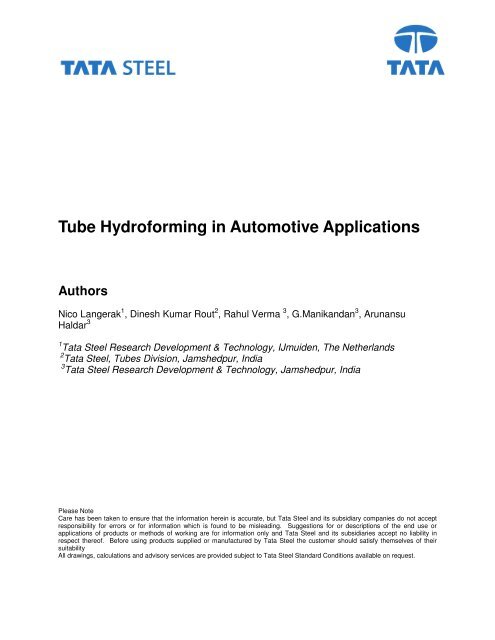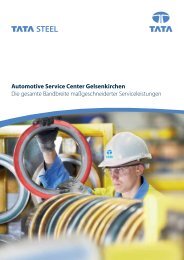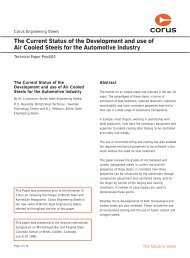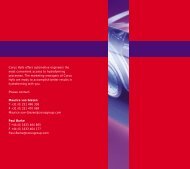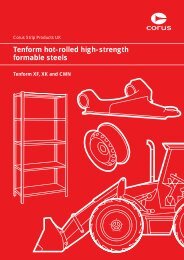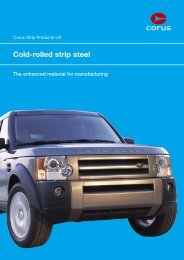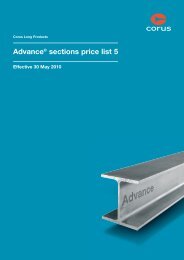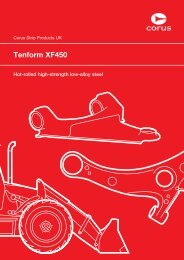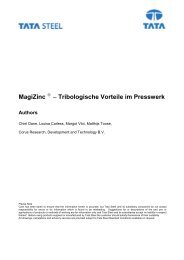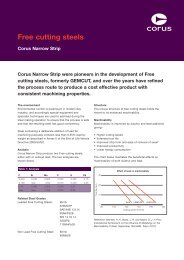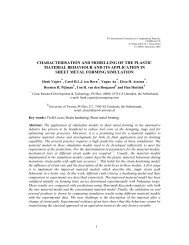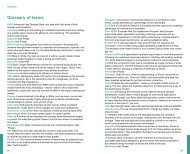Tube Hydroforming in Automotive Applications - Tata Steel in the ...
Tube Hydroforming in Automotive Applications - Tata Steel in the ...
Tube Hydroforming in Automotive Applications - Tata Steel in the ...
You also want an ePaper? Increase the reach of your titles
YUMPU automatically turns print PDFs into web optimized ePapers that Google loves.
<strong>Tube</strong> <strong>Hydroform<strong>in</strong>g</strong> <strong>in</strong> <strong>Automotive</strong> <strong>Applications</strong>AuthorsNico Langerak 1 , D<strong>in</strong>esh Kumar Rout 2 , Rahul Verma 3 , G.Manikandan 3 , ArunansuHaldar 31 <strong>Tata</strong> <strong>Steel</strong> Research Development & Technology, IJmuiden, The Ne<strong>the</strong>rlands2 <strong>Tata</strong> <strong>Steel</strong>, <strong>Tube</strong>s Division, Jamshedpur, India3 <strong>Tata</strong> <strong>Steel</strong> Research Development & Technology, Jamshedpur, IndiaPlease NoteCare has been taken to ensure that <strong>the</strong> <strong>in</strong>formation here<strong>in</strong> is accurate, but <strong>Tata</strong> <strong>Steel</strong> and its subsidiary companies do not acceptresponsibility for errors or for <strong>in</strong>formation which is found to be mislead<strong>in</strong>g. Suggestions for or descriptions of <strong>the</strong> end use orapplications of products or methods of work<strong>in</strong>g are for <strong>in</strong>formation only and <strong>Tata</strong> <strong>Steel</strong> and its subsidiaries accept no liability <strong>in</strong>respect <strong>the</strong>reof. Before us<strong>in</strong>g products supplied or manufactured by <strong>Tata</strong> <strong>Steel</strong> <strong>the</strong> customer should satisfy <strong>the</strong>mselves of <strong>the</strong>irsuitabilityAll draw<strong>in</strong>gs, calculations and advisory services are provided subject to <strong>Tata</strong> <strong>Steel</strong> Standard Conditions available on request.
<strong>Tube</strong>Press for clos<strong>in</strong>gforceCyl<strong>in</strong>ders foraxial feed<strong>in</strong>gToolsFigure 1.<strong>Tube</strong> hydoform<strong>in</strong>g.Source: Metal form<strong>in</strong>gIn figure 2 a typical sequence is shown for tube hydroform<strong>in</strong>g of a simple T-component. First <strong>the</strong> tube willbe positioned <strong>in</strong> <strong>the</strong> die set, <strong>the</strong> tools will close and <strong>the</strong> tube will be filled with water. Axial feed<strong>in</strong>g willbuild up pressure and enable <strong>the</strong> <strong>in</strong>flow of material <strong>in</strong>to <strong>the</strong> T-shape. After releas<strong>in</strong>g <strong>the</strong> pressure, <strong>the</strong> diescan be opened and <strong>the</strong> part be removed.Position<strong>in</strong>gClos<strong>in</strong>g andAxial feed<strong>in</strong>g andF<strong>in</strong>ishedSource: Metal form<strong>in</strong>g handbook,Figure 2. <strong>Tube</strong> hydroform<strong>in</strong>g sequence for a T-shapeIn figure 3 a number of typical hydroformed components <strong>in</strong> a car are shown, <strong>in</strong>clud<strong>in</strong>g a bumper system,A pillar, space frame and exhaust components.Figure 3. Typical hydroformed tube componentsApart from various commercial applications a number of studies have been done on <strong>the</strong> use ofhydroformed tubular components <strong>in</strong> car body. In figure 4, an example is shown of a Hydrofrom IntensiveBody, designed by Land Rover <strong>in</strong> cooperation with <strong>Tata</strong> <strong>Steel</strong> and a number of <strong>Hydroform<strong>in</strong>g</strong> companies.In this body an number of traditional sheet metal components have been replaced by hydroformed tubes,lead<strong>in</strong>g to lesser components, weight sav<strong>in</strong>g and an excellent crash performance.
Figure 4. Land Rover Hydroform Intensive BodyAlthough tube hydroform<strong>in</strong>g is a long known technology, <strong>the</strong> applications of hydroformed tubularcomponents has <strong>in</strong>creased <strong>in</strong> recent times, because of <strong>the</strong> more advanced press<strong>in</strong>g control technology,but also because of <strong>the</strong> availability of reliable F<strong>in</strong>ite Element Models (FEM), that elim<strong>in</strong>ate <strong>the</strong> expensivetrial and error process <strong>in</strong> <strong>the</strong> development of <strong>the</strong> tools an components. In figure 5 and 6 an example isshown of a state of <strong>the</strong> art FEM analyses of <strong>the</strong> complete production process, start<strong>in</strong>g with tube mak<strong>in</strong>gon a roll form<strong>in</strong>g l<strong>in</strong>e (figure 5) followed by pre- bend<strong>in</strong>g of <strong>the</strong> tubes, clos<strong>in</strong>g of <strong>the</strong> tools also pre form<strong>in</strong>g<strong>the</strong> tube and f<strong>in</strong>ally <strong>the</strong> hydroform<strong>in</strong>g step (figure 6).Figure 5. FEM calculations of <strong>the</strong> tube mak<strong>in</strong>g process.Bend<strong>in</strong>g tubeClos<strong>in</strong>g tools<strong>Hydroform<strong>in</strong>g</strong> tubeFigure 6. FEM calculations of Pre-bend<strong>in</strong>g , tool clos<strong>in</strong>g and hydroform<strong>in</strong>g
Apart from tube hydroform<strong>in</strong>g much research is done <strong>in</strong> sheet hyfdroform<strong>in</strong>g, although <strong>the</strong> number ofactual applications is still relative limited. In figure 7 <strong>the</strong> classical method for sheet metal form<strong>in</strong>g isshown, where <strong>the</strong> hydraulic fluid is used as a flexible die <strong>in</strong> a traditional deepdraw<strong>in</strong>g process ofcyl<strong>in</strong>drical components. In this way <strong>the</strong> deep drawability can be <strong>in</strong>creased significantly, lead<strong>in</strong>g to muchlarger deep draw<strong>in</strong>g ratios compared to traditional deep drawn components.Figure 7. Sheet hydroform<strong>in</strong>gApart from analyz<strong>in</strong>g this process with FEM, <strong>Tata</strong> <strong>Steel</strong> uses automated stra<strong>in</strong> measurement systems tomeasure <strong>the</strong> severity of <strong>the</strong> form<strong>in</strong>g process and optimize <strong>the</strong> component and process. In figure 8. anexample is shown of a conical component, on which a grid mark has been applied prior to hydroform<strong>in</strong>g.After <strong>the</strong> form<strong>in</strong>g process <strong>the</strong> grid mark has been measured with an optical automated stra<strong>in</strong> analysessystem and <strong>the</strong> m<strong>in</strong>or and major stra<strong>in</strong> are plotted <strong>in</strong> a Form<strong>in</strong>g Limit Diagram, show<strong>in</strong>g that <strong>the</strong> form<strong>in</strong>gof this component with a high deep draw<strong>in</strong>g ratio of this material is feasible.BCAABCFigure 8. Stra<strong>in</strong> analyses of a conical hydroformed component.Apart from sheet hydroform<strong>in</strong>g as an enhancement of <strong>the</strong> classical deep draw<strong>in</strong>g process, a specialprocess has been developed especially for automotive outer components called <strong>the</strong> Hydromec process.In figure 9 <strong>the</strong> pr<strong>in</strong>ciple of this method is shown where a sheet is pre-formed <strong>in</strong> one direction generat<strong>in</strong>g auniform stra<strong>in</strong> <strong>in</strong> <strong>the</strong> sheet. After that a mechanical punch will press <strong>the</strong> sheet <strong>in</strong> <strong>the</strong> o<strong>the</strong>r direction giv<strong>in</strong>g<strong>the</strong> component its f<strong>in</strong>al shape, supported by <strong>the</strong> hydraulic fluid. In this way a component with a lot of prestra<strong>in</strong>will be pressed, which will give <strong>the</strong> component excellent dent resistance, especially when so called
ake harden<strong>in</strong>g steels are used that raise <strong>the</strong> Yield strength of a pre-formed component considerablydur<strong>in</strong>g <strong>the</strong> pa<strong>in</strong>t cycle.Figure 8a. The Hydromec process.Figure 8b. A Hydromec bonnetIn figure 9 ano<strong>the</strong>r special form of sheet hydroform<strong>in</strong>g is shown, <strong>the</strong> so called pillow hydroform<strong>in</strong>g, where2 stacked sheets are presses toge<strong>the</strong>r <strong>in</strong> one toolset <strong>in</strong>to a an outer and <strong>in</strong>ner panel of <strong>in</strong> this case abonnet, reduc<strong>in</strong>g cycle time, tool costs and <strong>in</strong>creas<strong>in</strong>g dent resistance.Figure 9. Pillow sheet hydroform<strong>in</strong>g.
Example: Bumper systemThe first <strong>in</strong>dustrial component which will be shown is a bumper system, where <strong>the</strong> aim was to replace aclassical sheet metal bumper system constructed of a number of stamped sheet metal components(figure 10) by a s<strong>in</strong>gle hydrodformed tubular component (figure 11) [2].Figure 10. Orig<strong>in</strong>al sheet metal bumper systemFigure 11. Redesigned hydroformed componentA number of material requirements for <strong>the</strong> performance of this crash component were determ<strong>in</strong>ed:–Energy absorption–Strength–DuctilityAll requirements were evaluated and optimized us<strong>in</strong>g FEM.One important aspect for this component was <strong>the</strong> so called corner fill<strong>in</strong>g at <strong>the</strong> relative sharp radii of <strong>the</strong>component. At <strong>the</strong> end pieces of <strong>the</strong> component, <strong>the</strong> corner fill<strong>in</strong>g can be controlled by <strong>the</strong> axial feed to<strong>the</strong> tube. However <strong>in</strong> <strong>the</strong> middle of <strong>the</strong> component <strong>the</strong> full corner fill<strong>in</strong>g has to be obta<strong>in</strong>ed from <strong>the</strong> tubecircumference <strong>in</strong> plane stra<strong>in</strong> condition (figure 12).Figure 12 Corner fill<strong>in</strong>g areasThe corner fill<strong>in</strong>g behaviour of various advanced steel tubes has extensively been researched us<strong>in</strong>g aresearch part as shown <strong>in</strong> figure 13. These experiments were also simulated us<strong>in</strong>g FEM enabl<strong>in</strong>g todeterm<strong>in</strong>e <strong>the</strong> reliability of this method. Figure 13 shows that <strong>the</strong> primary stra<strong>in</strong> peaks at <strong>the</strong> contact edgefound <strong>in</strong> <strong>the</strong> experiment are well predicted by <strong>the</strong> FE method. The secondary stra<strong>in</strong> peak at <strong>the</strong> centre of<strong>the</strong> corner is less well predicted, however <strong>the</strong> failure position is at <strong>the</strong> contact edge, so this is <strong>the</strong> mostrelevant one.
Figure 13a Corner fill<strong>in</strong>g test specimenFigure 13b Cross section of <strong>the</strong> tubeFigure 13. Comparison of experimental and numerical of <strong>the</strong> corner fill<strong>in</strong>g test.In figure 14. simulations are shown for various advanced steel types. It is clear that materials like DP andTRIP with a high n-value show low stra<strong>in</strong> peaks.
Figure 14. Corner fill<strong>in</strong>g simulations of various advanced materials at low stra<strong>in</strong>s.At higher stra<strong>in</strong>s (figure 15) we see <strong>the</strong> HSLA grade fail and <strong>the</strong> DP800 grade be very close to <strong>the</strong> failurelimit. DP600 and TRIP show favourable behaviour for this component.Figure 15. Corner fill<strong>in</strong>g simulations of various advanced materials at high stra<strong>in</strong>s.The behaviour of a tube dur<strong>in</strong>g hydroform<strong>in</strong>g can be tested us<strong>in</strong>g <strong>the</strong> so called free expansion test (FET)as shown <strong>in</strong> figure 16. With this tester a tube can be freely expanded until burst<strong>in</strong>g. By apply<strong>in</strong>g axialfeed, a Form<strong>in</strong>g Limit Curve can be constructed for a tube.Figure 16. Free expansion tester an form<strong>in</strong>g Limit Curve for a tube.In figure 17, it is expla<strong>in</strong>ed that it is important to test <strong>the</strong> tube <strong>in</strong> a FET test and not only <strong>the</strong> orig<strong>in</strong>al sheetmaterial as because of <strong>the</strong> tube mak<strong>in</strong>g process, <strong>the</strong> mechanical behaviour of <strong>the</strong> f<strong>in</strong>al tube is not <strong>the</strong>same as of <strong>the</strong> orig<strong>in</strong>al sheet material. The FET test enables to test very high elongation levelscomparable to tube hydroform<strong>in</strong>g and normally no weld failure will occur, giv<strong>in</strong>g <strong>the</strong> actual mechanicalmaterial behaviour.Figure 17. Comparison of sheet and tube materialApart from he mechanical properties of <strong>the</strong> f<strong>in</strong>al tube, also <strong>the</strong> friction dur<strong>in</strong>g <strong>the</strong> hydroform<strong>in</strong>g processplays an important role. In figure 18. <strong>the</strong> <strong>in</strong>fluence of friction is shown for <strong>the</strong> corner fill<strong>in</strong>g test. It is clearthat a lower friction lowers <strong>the</strong> stra<strong>in</strong> peaks. This improves <strong>the</strong> formability and enables <strong>the</strong> use ofmaterials with lower formability to produce a complicated component.
Figure 18. The <strong>in</strong>fluenced of friction on hydroform<strong>in</strong>gIn figure 19 and 20 <strong>the</strong> FEM calculations were shown of <strong>the</strong> actual bumper component. The corner filltest, <strong>the</strong> FET test and <strong>the</strong> FEM calculations were used to optimize <strong>the</strong> shape of <strong>the</strong> component as well as<strong>the</strong> pre-bend<strong>in</strong>g, pre-form<strong>in</strong>g and axial feed at hydroform<strong>in</strong>g. This has led to optimal corner fill<strong>in</strong>g and acomponent that met crash requirements.Figure 19 FEM calculations of <strong>the</strong> bumper systemFigure 20. F<strong>in</strong>al component show<strong>in</strong>g successful corner fill<strong>in</strong>g and rest ductility for crash performanceExample: eng<strong>in</strong>e cradleThe use of Advanced <strong>Steel</strong>s <strong>in</strong> hydroform<strong>in</strong>g need careful considerations; a good example is <strong>the</strong> Eng<strong>in</strong>ecradle shown Figure 21 [3].
Figure 21. Eng<strong>in</strong>e Cradle from tube made from DP600At first glance this component is a typical example of <strong>the</strong> use of hydroform<strong>in</strong>g to replace severalconventional stamped parts by one hydroform<strong>in</strong>g component, but it also uses <strong>the</strong> benefits of a HighStrength steel grade result<strong>in</strong>g <strong>in</strong> a lighter solution.However, successfully hydroform<strong>in</strong>g this eng<strong>in</strong>e cradle <strong>in</strong> particular and Dual Phase materials <strong>in</strong> general,is not an easy task. The hydroform<strong>in</strong>g process of this eng<strong>in</strong>e cradle was already <strong>the</strong> subject of a paper at<strong>the</strong> 2001 [4] <strong>Hydroform<strong>in</strong>g</strong> Conference <strong>in</strong> Pamplona. In pr<strong>in</strong>ciple <strong>the</strong> limits of hydroform<strong>in</strong>g High Strength<strong>Steel</strong>s should be taken <strong>in</strong>to account at <strong>the</strong> very early stage of <strong>the</strong> design process <strong>in</strong> order to avoid anyproblems <strong>in</strong> a later stage, <strong>in</strong> this case Advanced High Strength <strong>Steel</strong>s were new to <strong>the</strong> market and alimited amount of data was available to support <strong>the</strong> development process.After extensive studies at <strong>the</strong> later stages of development, <strong>the</strong> eng<strong>in</strong>e cradle has been produced from a<strong>Tata</strong> <strong>Steel</strong> <strong>Tube</strong>, which is a press formed and laser welded tube designed to <strong>in</strong>crease <strong>the</strong> potentialoptions for hydroform<strong>in</strong>g applications.The eng<strong>in</strong>e cradle was <strong>in</strong>itially produced from a conventional roll formed and resistance welded tube(ERW). However, <strong>the</strong> comb<strong>in</strong>ation of material and process for this application results <strong>in</strong> two problems.• Excessive stra<strong>in</strong> harden<strong>in</strong>g <strong>in</strong>troduced by <strong>the</strong> roll form<strong>in</strong>g process• A negative <strong>in</strong>fluence on <strong>the</strong> local mechanical properties due to <strong>the</strong> heat <strong>in</strong>put of <strong>the</strong> resistanceweld<strong>in</strong>g processThe stra<strong>in</strong> harden<strong>in</strong>g <strong>in</strong>troduced by <strong>the</strong> roll form<strong>in</strong>g process is a result of <strong>the</strong> developments of stra<strong>in</strong>s <strong>in</strong>both <strong>the</strong> longitud<strong>in</strong>al direction and <strong>the</strong> circumferential direction of <strong>the</strong> tube. The longitud<strong>in</strong>al stra<strong>in</strong>s arema<strong>in</strong>ly geometry based and can be estimated by analytical software packages such as Copra TM .The circumferential stra<strong>in</strong>s are ma<strong>in</strong>ly a result of <strong>the</strong> calibration stands <strong>in</strong> <strong>the</strong> tube mill and can beestimated by modell<strong>in</strong>g <strong>the</strong> tube mak<strong>in</strong>g process <strong>in</strong> a F<strong>in</strong>ite Element model. Although we were unable tomeasure a specific example of this particular Dual Phase tube <strong>in</strong> its unformed state, previousmeasurements and calculations performed by <strong>Tata</strong> <strong>Steel</strong> showed that this can be as much as 6% andhigher [5].Anneal<strong>in</strong>g can be used for mild steel tubes to recover formability after stra<strong>in</strong> harden<strong>in</strong>g, but is not possiblefor Dual Phase steels, s<strong>in</strong>ce this would destroy <strong>the</strong> martensitic phase <strong>in</strong> <strong>the</strong> material. Therefore, <strong>the</strong>
stra<strong>in</strong>s <strong>in</strong>troduced by <strong>the</strong> roll form<strong>in</strong>g process are unrecoverable result<strong>in</strong>g <strong>in</strong> a relatively poorlyhydroformable tube.The resistance weld<strong>in</strong>g process <strong>in</strong>troduces a relatively large amount of heat <strong>in</strong>to a local area <strong>in</strong> <strong>the</strong>circumference of <strong>the</strong> tube. This heat <strong>in</strong>put results <strong>in</strong> various changes <strong>in</strong> <strong>the</strong> microstructure. The meltedregion turns <strong>in</strong>to a martensitic and ba<strong>in</strong>itic structure after cool<strong>in</strong>g down.Figure 22a shows <strong>the</strong> microstructure of a resistance-welded Dual Phase tube. The melted regionbecomes relatively hard (430 Hv, see Figure 23) and <strong>the</strong>refore has a high yield stress, result<strong>in</strong>g <strong>in</strong> apoorly formable but strong region. However, <strong>the</strong> heat <strong>in</strong>put also <strong>in</strong>fluences <strong>the</strong> heat-affected zone (HAZ),which concerns <strong>the</strong> material immediately adjacent to <strong>the</strong> weld. Figure 22a shows <strong>the</strong> microstructure ofthis HAZ. The heat <strong>in</strong>put results <strong>in</strong> a slightly softer region, this softer region can also be recognized <strong>in</strong> <strong>the</strong>hardness curve of Figure 23. It is exactly this softened region, which results <strong>in</strong> problems dur<strong>in</strong>ghydroform<strong>in</strong>g.a) Resistance weldb) Laser weld (CO 2 )Figure 22. Micro structure of Dual Phase 600 welds seamsHardness (Hv)500450400350300250200Laser weldInduction weld0 1 2 3 4 5position (mm)Figure 23 - Hardness profile of a Dual Phase 600 resistance weld and a Laser weldIt is assumed that <strong>the</strong> softened region has a slightly lower yield stress than <strong>the</strong> neighbour<strong>in</strong>g material(mo<strong>the</strong>r material and weld seam). The hydroform<strong>in</strong>g process encourages deformation at this weak region<strong>in</strong> <strong>the</strong> tube circumference. This deformation results <strong>in</strong> local th<strong>in</strong>n<strong>in</strong>g and <strong>in</strong> stra<strong>in</strong> harden<strong>in</strong>g (yield stress<strong>in</strong>crease).
Dual Phase materials have a very high n-value at <strong>the</strong> beg<strong>in</strong>n<strong>in</strong>g of <strong>the</strong> stress stra<strong>in</strong> curve (see Figure 24and Table 1) result<strong>in</strong>g <strong>in</strong> a rapid <strong>in</strong>crease of <strong>the</strong> yield stress for small deformations (stra<strong>in</strong> harden<strong>in</strong>g).However <strong>the</strong> n-value at higher stra<strong>in</strong> levels is much lower (see Figure 24 and Table 1) such that itbecomes more sensitive to stra<strong>in</strong> localization around pre-exist<strong>in</strong>g defects or geometry constra<strong>in</strong>ts, <strong>in</strong> thiscase a pre-exist<strong>in</strong>g material defect like a softened HAZ.stress MPa70060050040030020010000 5 10 15 20 25 30stra<strong>in</strong> %(specimen taken <strong>in</strong> <strong>the</strong> roll<strong>in</strong>g direction)Rp Rm n-value n-value(MPa) (MPa) (6%-8%) (10%-Ag)417 647 0.181 0.157Figure 24. Typical Dual Phase 600 tensile test curveTable 1. Typical mechanical properties of a Dual Phase 600 material (specimen taken under 90° to <strong>the</strong>roll<strong>in</strong>g direction)Dur<strong>in</strong>g a free-expansion test <strong>the</strong> tube is expanded under <strong>in</strong>ternal pressure over a free length of at leastthree times <strong>the</strong> tube diameter. The radial expansion is measured dur<strong>in</strong>g <strong>the</strong> test. The radial expansion atfailure is <strong>the</strong>n used to quantify <strong>the</strong> formability of <strong>the</strong> tube.Free-expansion test results also support <strong>the</strong> two observations above, failure takes place <strong>in</strong> <strong>the</strong> HAZ at lowexpansion levels (less than 10% radial expansion under plane stra<strong>in</strong> conditions).Figure 25a shows an example of a freely expanded roll formed and resistance welded Dual Phase 600tube. Figure 26 shows <strong>the</strong> pressure-expansion curve recorded dur<strong>in</strong>g <strong>the</strong> free-expansion test of <strong>the</strong> tubeorig<strong>in</strong>ally dest<strong>in</strong>ed for <strong>the</strong> production of <strong>the</strong> eng<strong>in</strong>e cradle.a) Roll formed and resistance welded tube
) The Tubular BlankFigure 25. Typical failure modes after free-expansion test<strong>in</strong>g of DP600.400Measured Datap [bar] (Pressure)350300250200150100500ERWTuB0 2 4 6 8 10 12Radial Direction (mm)Figure 26. Pressure expansion curves measured dur<strong>in</strong>g <strong>the</strong> expansion of a conventional roll formedresistance welded tube and a Tubular BlankThe DP600 Tubular Blank typically is better formable than a conventional roll formed and resistancewelded tube. The process uses press form<strong>in</strong>g <strong>in</strong> comb<strong>in</strong>ation with laser weld<strong>in</strong>g.Theory suggests that <strong>the</strong> press form<strong>in</strong>g process should develop less stra<strong>in</strong> harden<strong>in</strong>g. A F<strong>in</strong>ite Elementsimulation of <strong>the</strong> press form<strong>in</strong>g process was carried out to verify this. Figure 27 shows <strong>the</strong> result of <strong>the</strong>F<strong>in</strong>ite Element simulation and it clearly predicts an even stra<strong>in</strong> distribution and a low maximum stra<strong>in</strong> levelof only 2%. A roll formed tube generally shows a non-even stra<strong>in</strong> distribution <strong>in</strong> comb<strong>in</strong>ation with amaximum stra<strong>in</strong> level of approximately 6%.formed Dual Phase 600 Tubular BlankFigure 27. Calculated equivalent stra<strong>in</strong> distribution <strong>in</strong> a pressThe two disadvantages of <strong>the</strong> conventional roll form<strong>in</strong>g and resistance-weld<strong>in</strong>g process mentioned abovealso resulted <strong>in</strong> serious difficulties dur<strong>in</strong>g <strong>the</strong> <strong>Hydroform<strong>in</strong>g</strong> process of <strong>the</strong> eng<strong>in</strong>e cradle.
<strong>Tata</strong> <strong>Steel</strong> was <strong>the</strong>refore asked to <strong>in</strong>vestigate us<strong>in</strong>g <strong>the</strong> Tubular Blank (a laser welded and roll formedproduct) to establish whe<strong>the</strong>r <strong>the</strong> stated benefits:• Low stra<strong>in</strong> harden<strong>in</strong>g dur<strong>in</strong>g <strong>the</strong> form<strong>in</strong>g of <strong>the</strong> Tubular Blank• A small HAZ as a result of <strong>the</strong> laser weld<strong>in</strong>g Processcould help solve <strong>the</strong> problems.<strong>Tata</strong> <strong>Steel</strong> carried out basic F<strong>in</strong>ite Element simulation of <strong>the</strong> part <strong>in</strong> order to <strong>in</strong>vestigate <strong>the</strong> expectedmaximum stra<strong>in</strong> levels. These studies show that a maximum major stra<strong>in</strong> level of 20% is required underplane stra<strong>in</strong> conditions (see Figure 28).Figure 28 Predicted required stra<strong>in</strong> distribution <strong>in</strong> <strong>the</strong> componentSeveral critical areas are def<strong>in</strong>ed; four critical areas are a result of corner fill<strong>in</strong>g and two areas are criticalas a result of <strong>the</strong> pre-bend<strong>in</strong>g operation. The latter two areas are less critical s<strong>in</strong>ce <strong>the</strong>se areas are notplane stra<strong>in</strong>.This stra<strong>in</strong> level is considered very critical for Dual Phase material. It is <strong>the</strong>refore concluded that us<strong>in</strong>g aconventional roll formed tube will <strong>in</strong>deed result <strong>in</strong> serious problems <strong>in</strong> hydroform<strong>in</strong>g. However, it isregarded critical but feasible if a Dual Phase Tubular Blank is used for this application.When <strong>the</strong> production of <strong>the</strong> eng<strong>in</strong>e cradle us<strong>in</strong>g The Tubular Blank started, a cont<strong>in</strong>uous improvementprocess was <strong>in</strong>itiated. This cont<strong>in</strong>ued improvement focused on <strong>the</strong> through process cha<strong>in</strong> characteristicsof subsequent analysis of <strong>the</strong> performance of <strong>the</strong> Dual Phase Tubular Blank at <strong>the</strong> different productionsteps. These steps are:-Bend<strong>in</strong>g-Pre form<strong>in</strong>g-<strong>Hydroform<strong>in</strong>g</strong>Figure 29a shows a Tubular Blank after bend<strong>in</strong>g. The bend<strong>in</strong>g of The Tubular Blanks generally does notcause significant problems. However, it was found that <strong>the</strong> bend<strong>in</strong>g set-up needs to be adapted, ifTubular Blanks are used. Dual Phase materials exhibit high spr<strong>in</strong>gback [6]. The Tubular Blank is<strong>in</strong>herently softer than <strong>the</strong> conventional roll formed tubes for a given material grade. Therefore <strong>the</strong>spr<strong>in</strong>gback behaviour of a Tubular Blank compared to a Roll Formed tube is also different (<strong>the</strong> spr<strong>in</strong>gbackof a Tubular Blank is generally less). Experience also shows that <strong>the</strong> amount of spr<strong>in</strong>gback can varybetween different material batches, this is ma<strong>in</strong>ly a result of variations <strong>in</strong> <strong>the</strong> yield stress of <strong>the</strong> material.Dual Phase materials are very sensitive to <strong>the</strong>se changes, recall<strong>in</strong>g <strong>the</strong> earlier comment regard<strong>in</strong>g <strong>the</strong>stress/stra<strong>in</strong> characteristics (see Figure 24). Therefore, small variations <strong>in</strong> stra<strong>in</strong> levels <strong>in</strong>troduced dur<strong>in</strong>g
<strong>the</strong> material production process result <strong>in</strong> large variations <strong>in</strong> both <strong>the</strong> yield stress and <strong>the</strong> spr<strong>in</strong>gbackbehaviour. It is <strong>the</strong>refore advisable to take <strong>the</strong>se variations <strong>in</strong>to account <strong>in</strong> order to design a robustprocess, when Dual Phase materials are used.Figure 29b shows The Tubular Blank after pre-form<strong>in</strong>g. The pre-form<strong>in</strong>g of <strong>the</strong> product does not pose anysignificant problems. However, aga<strong>in</strong> it should be kept <strong>in</strong> m<strong>in</strong>d that Dual Phase materials can showvariation <strong>in</strong> spr<strong>in</strong>gback behaviour. The pre-form<strong>in</strong>g step could well be used to correct <strong>the</strong> geometryvariations after bend<strong>in</strong>g.Figure 29c shows <strong>the</strong> eng<strong>in</strong>e cradle after hydroform<strong>in</strong>g. The use of The Tubular Blanks resulted <strong>in</strong> adramatic improvement of <strong>the</strong> reject level after hydroform<strong>in</strong>g. This proved that hydroform<strong>in</strong>g <strong>the</strong> eng<strong>in</strong>ecradle is <strong>in</strong>deed feasible us<strong>in</strong>g this new tube mak<strong>in</strong>g technology.a) pre-bend<strong>in</strong>gb) pre-form<strong>in</strong>g
c) hydroform<strong>in</strong>gFigure 29. The Tubular Blank after each process stepDual Phase materials can result <strong>in</strong> lightweight components with high performance s<strong>in</strong>ce <strong>the</strong> yield stressand especially <strong>the</strong> Ultimate Tensile Stress is attractively high.In addition <strong>the</strong> aforementioned characteristics of <strong>the</strong> Dual Phase stress stra<strong>in</strong> curve also means that yieldstress will <strong>in</strong>crease dramatically dur<strong>in</strong>g <strong>the</strong> hydroform<strong>in</strong>g process. This comb<strong>in</strong>ation of material andprocess characteristics improves <strong>the</strong> performance possibilities of a Dual Phase component.Figure 30 shows <strong>the</strong> tensile test results of a specimen taken from <strong>the</strong> actual hydroformed eng<strong>in</strong>e cradle.Here, <strong>the</strong> hydroform<strong>in</strong>g process resulted <strong>in</strong> a yield stress of 548MPa, which is an <strong>in</strong>crease of over 30%.The location where <strong>the</strong> tensile specimen was taken is <strong>in</strong>dicated <strong>in</strong> Figure 29c.Stress (Mpa)80070060050040030020010000 5 10 15stra<strong>in</strong> %Figure 30. Tensile test data of a specimen taken from <strong>the</strong> eng<strong>in</strong>e cradle after hydroform<strong>in</strong>g (location seefigure 29c)Figure 31 shows <strong>the</strong> yield stress <strong>in</strong>crease measured on freely expanded Tubular Blanks at differentexpansion levels, confirm<strong>in</strong>g that low expansion levels result <strong>in</strong> high <strong>in</strong>creases <strong>in</strong> yield stress.
700600500Rp (Mpa)40030020010000 2 4 6 8 10radial expansion %Figure 31. Yield stress <strong>in</strong>crease versus expansion level (tensile specimen are taken <strong>in</strong> <strong>the</strong> longitud<strong>in</strong>aldirection of freely expanded tubes at different expansion levels)The capability to develop ‘as formed’ material properties <strong>in</strong> crash performance simulation is a key area ofresearch that will allow <strong>the</strong> car designer to fur<strong>the</strong>r optimize <strong>the</strong> performance of <strong>the</strong> structure.Whilst <strong>the</strong> mechanics of this process are conta<strong>in</strong>ed with<strong>in</strong> commercially availableanalysis codes, a practical methodology to execute this with hydroform components, <strong>in</strong> a rout<strong>in</strong>e analysis,with<strong>in</strong> a practical time frame is not.Follow<strong>in</strong>g a successful program for metal stamp<strong>in</strong>g, a work program for hydroform<strong>in</strong>g has beencompleted and presented [4].The ability to predict with <strong>in</strong>creased accuracy <strong>the</strong> benefits of comb<strong>in</strong><strong>in</strong>g Advanced High Strength <strong>Steel</strong>with o<strong>the</strong>r aspects of <strong>the</strong> Tubular Blank, for example us<strong>in</strong>g tailored and conical blanks to overcomegeometrical design aspects, should lead to component and module solutions that offer maximum masssav<strong>in</strong>g benefits through hydroform<strong>in</strong>g.ConclusionsHydroformed tubes can be used to develop cost effective lightweight components.Knowledge of <strong>the</strong> full process cha<strong>in</strong> from slab to <strong>the</strong> performance of <strong>the</strong> actual hydroform<strong>in</strong>g product isvital to <strong>the</strong> successful use of Advanced <strong>Steel</strong>s <strong>in</strong> hydroform<strong>in</strong>g components. The material choicesignificantly <strong>in</strong>fluences <strong>the</strong> component and production process design, <strong>the</strong> process control throughout <strong>the</strong>supply cha<strong>in</strong> from slab to tube mak<strong>in</strong>g process strongly <strong>in</strong>fluences <strong>the</strong> success of <strong>the</strong> hydroform<strong>in</strong>gprocess.F<strong>in</strong>ally, <strong>the</strong> application of Advanced <strong>Steel</strong> delivers maximum benefit when comb<strong>in</strong>ed with appropriatetubular technology and a full understand<strong>in</strong>g of <strong>the</strong> impact of <strong>the</strong> material’s behavior <strong>in</strong> <strong>the</strong> vehicle.References[1] Schuler GMBH, Schuler Metal Form<strong>in</strong>g Handbook, April, 2006[2] M. Kelder, K. Edgar, Application of Dual-phase and o<strong>the</strong>r High Strength <strong>Steel</strong>s for Hydroform<strong>Applications</strong>, <strong>Tube</strong> and Pipe Association International and <strong>the</strong> Society of Manufactur<strong>in</strong>g Eng<strong>in</strong>eers, NorthAmerican <strong>Hydroform<strong>in</strong>g</strong> Conference and Exhibition1st October 2003, Dayton, Ohio[3] M. Kelder, T. Burton, Formability of New Advanced High-Strength <strong>Steel</strong>s for <strong>Hydroform<strong>in</strong>g</strong>, 2nd annualNorth American Hydroform Conference and Exhibition,Waterloo, 27-29st September 2004, Ontario, Canada[4] M. Innocente. Development and <strong>Applications</strong> of <strong>the</strong> <strong>Hydroform<strong>in</strong>g</strong> Process for <strong>the</strong> <strong>Automotive</strong> Industry.3 rd International <strong>Hydroform<strong>in</strong>g</strong> Conference October 2001 Pamplona, Spa<strong>in</strong>
[5] R. Peeters, M.Sc.Thesis 3D modell<strong>in</strong>g of <strong>the</strong> roll form<strong>in</strong>g processSimulation set up and validation of <strong>the</strong> roll form<strong>in</strong>g processand implementation <strong>in</strong> <strong>the</strong> hydroform<strong>in</strong>g process cha<strong>in</strong>,University of Twente, November 2001 Enschede, The Ne<strong>the</strong>rlands[6] M.F. Shi, G.H. Thomas and M.X. Chen, U.S. <strong>Steel</strong> <strong>Automotive</strong> Center, J.R. Fekete General MotorsCorp. Formability performance comparison between Dual Phase and HSLA steels. ISS 43 rd MechanicalWork<strong>in</strong>g and <strong>Steel</strong> Process<strong>in</strong>g Conference, October 2001 Charlotte N.C.[7] J Cafolla, R.W. Hall, D.P. Norman, IJ McGregor. ‘Form<strong>in</strong>g to Crash’ Simulation <strong>in</strong> Full Vehicle Models.4 th European LS-Dyna Users Conference May 2003, Ulm Germany


